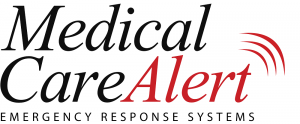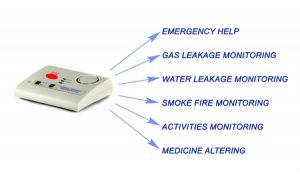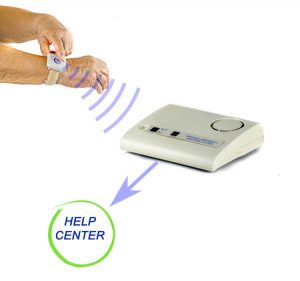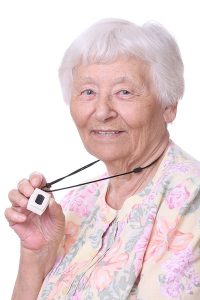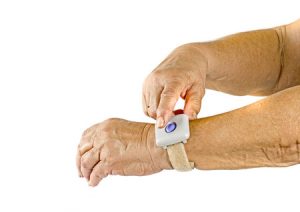Medical alert systems are wearable devices that allow senior citizens to receive emergency medical assistance at the touch of a button. These alert systems help the elderly continue to live independently as they age.
Our guide (updated for 2022) is meant to provide you with the information you need to choose the personal emergency response system that is right for the senior citizen in your life.
We took a look at all the top companies and compared features, prices, reputation, the good, the bad, and more. Continue reading if you’re seeking the best medical alert system for 2022.
Top Rated Medical Alert System Reviews
There are many different types of medical alerts for senior citizens. While the basic service is generally the same – instant access to emergency services – the features offered, pricing and reputation of each company tend to vary.
We took an in-depth look at all of the most popular emergency alert equipment for seniors and summarized the pros and cons below. If you’d like to more information on a particular company, simply click the “Read Review” button for our full-length medical alert reviews of each company.
Our #1 Choice!
With a strong commitment to customer care, Bay Alarm Medical has extensive expertise in home health services that goes back 70 years. Each Customer Care Consultant is a U.S.-based professional who has undergone extensive training and background checks. All customer data is encrypted against cyber threats, too.
What We Like:
- Wristwatch alert system easily goes wherever you go.
- Engaging on-site videos clearly explain how the system works.
- The system can connect to emergency services, family, friends, neighbors and more.
Where They Can Improve:
- Multiple payment methods encourage longer contracts.
- Extensive blog section can be complicated to navigate.
Prices range from $25.95 to $39.95 a month, depending on features. Price plans are monthly, quarterly and semi-annually. We recommend initially paying monthly until you’re sure the service will work for you. Then you should switch to a longer commitment, which will save you more money
For almost 30 years, Alert 1 has provided medical alert services to over 200,000 families and 10,000 medical professionals. They only provide emergency alert devices, so the entire company is dedicated to your safety. They offer high-quality, dependable services at a reasonable price.
What We Like:
- Many features to choose from including wireless, landline and mobile.
- No contracts or hidden fees. Pricing is transparent, and sales are pressure-free.
Where They Can Improve:
- Insurance plans might not cover costs.
- A free lock box with your purchase might not be a particularly useful item for most people.
With no contracts, you’re not committed to any long-term subscription plan. Prices are monthly and range from about $25 to $50 depending on the type of coverage. Generally speaking, Alert 1 prices are among the best value within the industry.
GreatCall is all about people, both their service technicians and their customers. With no contracts or cancellation fees, you can try them today without any risk. All support agents are U.S. based and extensively trained in emergency response procedures.
What We Like:
- Endorsed by John Walsh, a long-time personal security advocate and specialist.
- Exclusive provider of the Jitterbug smart and flip phone system.
- Greatcall Lively Mobile Alert and Wearable Medical Alert Buttons provide protection around your entire home.
Where They Can Improve:
- While the service is easy to use, there isn’t a ton of help documentation online.
- Phone accessories, such as chargers and screen protectors, must be purchased separately.
Subscription plans run from $20 to $35 a month. Smart and flip phones run $50 and more, depending on the features desired. The accessories are a little pricey compared to some other plans, but the services provided are top of the line.
Since 1979, LifeFone has provided life alert systems for seniors across the country. They offer trusted, professional service with up-to-date technology including their LifeFone base with both wrist and pendant portable units.
What We Like:
- Simple set-up involves plugging the unit into a wall outlet and landline phone jack.
- 3G cellular options including mobile apps and on-the-go monitoring across the U.S.
- Trusted company with a long-standing reputation for excellent customer service.
Where They Can Improve:
- While they offer many options and features, their website is a bit difficult to navigate. To ensure you get what you need, we recommend calling the company directly.
- They offer free shipping, but this is currently limited only to the summer season.
LifeFone units run from $25 to $45 a month, depending on the services you want. National GPS coverage is the highest priced option. All services include a lifetime pricing guarantee, meaning you can lock in a low price today. All plans also include a 30-day trial so you can try the service with no risk
This is a reliable, low-cost option for those on a budget. Monthly costs are less than $1 a day with a rate guaranteed never to increase. Plus, there is no contract which means you can cancel at any time.
What We Like:
- Alarm button can be worn around the neck or arm, and includes a microphone/speaker for two-way voice communication.
- Unique AlertMessage service automatically emails a loved one when there’s an emergency, system test or any system issues.
- Highly trained CSAA certified specialists undergo six weeks of classroom instruction.
Where They Can Improve:
- While the emergency call button is available in both pendant and wristwatch forms, your choices are limited to just one.
- There is a wealth of information on the website, but if you request a brochure, you’ll have to wait for it to arrive in the mail.
At $25, the base plan is priced about as low as it gets in this industry. For that price, you’re getting reliable, professional 24/7 protection. Fall monitoring, extra buttons, and other features are all very reasonably priced, usually around an additional $5 to $10 a month.
With a wide range of products, Medical Guardian offers options for every level of coverage. They offer free shipping, installation, and even free equipment. You might recognize Medical Guardian from their TV commercials which feature former Brady Bunch star and current safety advocate Florence Henderson.
What We Like:
- Classic, Home, Mobile and Premium Guardian coverage offer a full range of services for landlines, mobile and more.
- GPS location tracker has unlimited range and a battery life of 36 hours.
- CEO Geoff Gross founded the company after his grandmother fell in her home.
Where They Can Improve:
- The website is very busy. While we appreciate the abundance of info, finding specifics can be confusing.
- Free informational brochure requires an email address for delivery. While we trust Medical Guardian to guard our personal info, requiring an email address for a free brochure is needlessly time-consuming.
Prices vary between $30 and $50 per month. Basic coverage costs less than $1 a month. There are no long-term contracts, and you can cancel at any time.
Instant two-way voice communication with a trained medical professional at the push of a button, the Medical Care Alert system is easy and dependable. The mobile GPS alarm button can be worn as a necklace or around your arm. They are a Michigan-based company with U.S. based service centers in California and New York.
What We Like:
- The lightweight button can go anywhere, even outdoors, with complete GPS functionality.
- Recipient of the Angie’s List Super Service Award for 2012, 2013, 2014 and 2015.
- No equipment or setup costs.
Where They Can Improve:
- Multiple contact phone numbers depending on your particular issue might be confusing for seniors.
- Installation with a landline is very simple but connecting to a mobile device might be more difficult.
Home coverage is $27 a month. Extended coverage, which will cover most yards, costs $32. For complete freedom, the Go Anywhere plan with GPS tracking and fall coverage costs $36.
Endorsed by both Leeza Gibbons and Betty White, Philips Lifeline offers reliable medical alert services for both landlines and mobile devices. They’re the only company to offer AutoAlert, which automatically detects a fall even if the user can’t press the help button because they’re immobilized or unconscious. Works both at home and away.
For just $14 you can buy a Medical Alert app for your mobile device. This is an excellent way to get medical coverage without setting up a full system. Their traditional medical alert services range from about $35 to $50 per month, depending the number of extra features you use.
What We Like:
- Considering falls are the number one cause of external injuries to seniors; their medical alert systems with fall detection are a major selling point.
- Their high quality, certified staff is available 24/7.
- The company was created in 1972 by Dr. Andrew Dibner. They’re one of the oldest medical alert businesses in North America.
Where They Can Improve:
- A wide range of support materials on their website is useful, but a little confusing to access.
- Their $60 medication dispenser is a bit costly.
The prices for their alert services are very reasonable. The Home only system is $30 a month. The same system with the AutoAlert FallSafe Detection system is $45 a month. Finally, their GPS on-the-go system with Fall Detection is $55 a month.
How We Ranked Each Company
We thoroughly examined each provider to provide an honest and transparent ranking of each company.
We looked at each company’s features, prices, reputation, and overall customer satisfaction. While some companies are better than others, all of the ones on our list are very high quality.
Keep in mind; the best medical alert system is the one which best suits your specific needs. Take some time to determine how you plan to use the system. This will prevent you from paying for features you’ll never use while ensuring you’ll have the ones you’ll need.
Medical Alert Systems Defined
Seniors often wish to live independently in their homes, but there are risks which must be considered.
As we age, our chances of suffering a household accident or medical emergency increase drastically. In fact, each year one in every three seniors are injured in a household fall.
If you’re a senior yourself or an adult child caring for an aging parent, a PERS is a good way of allowing for safe, independent home living.
With just one press of a button, you’ll instantly be connected to a trained professional who can contact local emergency services, friends, and family on your behalf.
The device is usually worn around the person’s neck or wrist. This lets the user to move freely around their house and yard while always having a lifeline to help.
How Do Medical Alert Devices Work?
A medical alert service allows anyone to connect easily with a trained professional who can then summon help.
The system consists of a button as well as microphone and speaker. Available wirelessly throughout your property, both inside and out, you simply press the button on the medical alert device, which can be on a necklace, belt, wristwatch or similar.
Pressing the button connects you via speakerphone with the support staff for the medical alert company.
This trained professional will then assess your needs and contact local emergency services, family members or other contacts. If you can’t speak, the staff will contact local medical services immediately.
Most emergency systems allow for two-way communication. You might remember the famous “I’ve fallen, and I can’t get up” commercials from a few decades ago.
Today, the basic idea is the same, but the technology is far more advanced. The communication device can include extra features such as GPS location, battery back-up, and fall detection.
There are usually two components:
- Main table top unit which sits on a night table or main living area.
- The remote transmitter is worn around the neck, wrist, waist, etc.
The main unit resembles an answering machine or speakerphone. While the specifics vary, each unit typically has four major buttons.
First, there’s an emergency button. This is usually a large button, labeled in large print English with an additional label in Braille. Pressing this button sends a signal to the emergency alert call center. Depending on the features, the device might flash, make a tone or create some other type of feedback.
Some services simply relay your contact info to the provider, who will then contact local emergency services on your behalf. This is a minimum level of service, usually chosen by those who are in otherwise good health and/or have a minimal budget.
Most medic alert systems – including the ones we review – allow for instant, two-way communication between the user and a professional working for the medical alert company.
This lets you talk to a patient, knowledgeable health care professional who will know the best course of action.
You might need emergency medical services and need immediate attention. The professional can instantly provide relevant info to the emergency services located closest to you. Quick, professional response can be the actual difference between life and death.
There might also be other people you need to contact during an emergency. Suppose you’re confused about your medication, and need an adult child to come over and help. You can press the emergency button, and the technician will connect you to any pre-designated family member or friend.
Many medic alerts also have some type of activity or life monitoring. The user is required to press a Home button once every 24 hours. Otherwise, the monitoring system will be notified. These systems flash and emit a series of beeps during the 15 minutes before the 24-hour checkpoint, to remind users. Almost 10 million seniors live alone, and Activity Monitoring services are a great way to provide peace of mind.
All medical alert units will have a power light indicator, so you can be sure everything is working fine. You want a unit with a battery backup so that you can contact help even during a power outage.
This is especially important if you live in an area where snow, winds or other weather often hinders your home power availability.
The base can be augmented with a portable unit, which is a small button worn on a clip or lanyard. You carry this on your person as your move around your property, and emergency services are accessible wherever you are. Some mobile units allow two-way communication, while less expensive ones only send an emergency signal.
If you travel, or wandering is an issue, you should consider the high-end units which provide nationwide GPS coverage.
Who Can Benefit From An Alert System?
Perhaps the greatest fear of growing old is the idea of losing one’s independence. Nobody wants to be a burden – financial, physical or otherwise – on their loved ones. Moving into a nursing care facility can be a frightening and unwelcome prospect.
Fortunately, med alert systems are a great solution. With the right system, you can live at home without fear. In the event of a fall or other medical emergency, help is available at the press of a button.
These systems are perfect for a variety of vulnerable individuals including:
- Seniors who live alone. For an elderly person living alone in their house, just one slip or fall can have serious consequences.
- Seniors who live with other seniors. Often, an older person is unable to help their spouse if they become incapacitated due to a fall.
- Epileptics. While many people can control their epilepsy with medication, there is always a risk of seizures, especially in children and recently diagnosed adults.
- Diabetics. Changes in blood sugar can lead to sudden seizures or even coma.
- Alzheimer’s Patients. Roughly six out of every 10 Alzheimer’s patients will wander away from home and become lost.
- Care Providers. Professional, in-home care providers can’t be around 24/7. These products can act as a backup plan if a provider is sick or otherwise temporarily unavailable.
Many folks of every age and health status choose a personal emergency system to provide safety, security and peace of mind.
Common Features Found in High Quality Systems
Different service providers offer varied services, but there are many standard features found in all brands. Here’s what to look for:
The tabletop unit will have:
- A powerful speaker and microphone used to communicate with the medical alert staff
- A clear light indicating the unit is powered up and running
- A large “Emergency” button for instant, one-touch assistance
- An Alarm/Status light for visual status confirmation
The personal call button will have:
- A lanyard so the device can be worn around your neck.
- A clip so the device can be attached to your waistband.
- A large, easy-to-press button with enough range to cover your home and surrounding yard.
- Some units will have additional features such as GPS and a built-in microphone. Others simply send an emergency signal.
Here are some considerations to keep in mind:
Does the user have any specific disabilities?
Stroke survivors and others with physical impairments might need a device which they can operate with just one hand.
How will the device be worn?
In some rare cases, a unit worn around the neck can be a strangulation risk. A wristband might irritate sensitive skin. You’ll need to find the right balance between comfort and accessibility.
Do you want additional help buttons?
Along with a personal unit, you might also want to mount other buttons throughout the house. Many people mount buttons near the floor where they can be reached in the event of a fall.
What power options do you need?
Almost all alert systems plug into a standard wall outlet. But you’ll likely want a system with a battery back-up, too. This lets you call for help even during a power failure.
What Should I Expect to Pay?
The medical alert companies listed above are legitimate, honest and backed by decades of experience.
Keep in mind that not all of them are the same. Medical Alert System Scams are on the rise. Many of these scams offer prices which are too good to be true.
You should expect to pay roughly $25 to $80 a month for a subscription plan. Most companies offer month to month contracts which you can cancel at any time. Be wary of any company which pressures you into signing a long-term contract. They’re likely not very reputable.
You will often have to purchase additional equipment or services, even from a legitimate company.
Extras such as GPS location, additional call buttons and more are often priced separately from the basic subscription plan. On average, you’re looking at anywhere from $5 to $15 extra, depending on the specific features you select.
Keep an eye out for free trials. Many of the companies listed above offer a 30-day money back guarantee. This is an excellent way to test the service with no financial risk.
Even with a monthly plan, you’re still not spending much money to try the service for 30 days. You should never commit to a long term contract for a service you’ve never used before.
Compare Medical Alert Systems for Seniors
The basics are always the same. You press a button and are connected to professional, emergency help.
However, not all systems are the same. There are a variety of different features offered.
Before you start shopping, make a list of the specific qualities you want in a system. Here are some common issues to consider
- Total Cost. Med alert systems typically operate with a subscription fee. Aside from the monthly charges, you’ll want to watch out for additional costs. These can include fees for activation, shipping, and equipment rental. Note that fees are common, and they can be reasonable, but you want to do your research to avoid any hidden surprises.
- Read the fine print before you commit to any contracts. Some companies require a commitment for up to a year, while others let you pay as you go. Investigate the policies for both refunds and cancellations.
- When comparing systems, look for differences. Every company will have a different emphasis. Some offer low prices. Others might have a few unique features. Still, others might have a long history of excellent service. Choose the service which fits your specific needs.
How to Avoid Being Scammed
Over 46.2 million people in the U.S. are over the age of 65, and this number is expected to increase for many more years. As the population ages, alert systems are growing in popularity. Unfortunately, medical alert scams are also on the rise.
AARP recently issued a report detailing how these scams work. First, you’ll receive a completely unexpected, unsolicited call. The caller will have good news: You’ve been selected to receive a free medical alert service!
Unfortunately, this is never the case. A legitimate medical alert service will never call you unprompted to offer you an exclusive deal.
The “free offer” is designed for one of two types of scams. First, the scammer might simply hit you up for hidden fees. Or the entire system might not exist at all, and the scammer simply wants your personal information to steal your identity.
Here are some useful tips to ensure scammers don’t take advantage of you:
- Be Aware. Simply knowing these scams exist gives you a huge advantage. Remember: Legitimate medical alert companies provide an honest service which customers are happy to pay for. They simply don’t need to offer their services for free.
- Be Proactive. If you’re interested in purchasing a subscription, you (or a loved one) will need to make initial contact with the company. You can’t trust any company which contacts you “out of the blue.”
- Be Privacy-Minded. NEVER give out personal information to someone who calls you unexpectedly. You’ll want to order directly from the company by using their website or calling their official phone number. That way you’re certain you’re dealing directly with the company.
Finally, reduce your risk by putting your number on the Do Not Call List. Use only DoNotCall.gov. This is the official No Call list run by the federal government. Any other do-not-call lists could very well be scams themselves, so only use that one official website.
If you’re ever contacted by a company which you believe might be a scam, speak out! Tell your friends and family. This helps everyone stay alert and avoid becoming the victim of fraud.
Frequently Asked Questions
Here are common questions that we are often asked. If you have a question that isn’t on the list, please contact us and we’ll add it!
- WHAT IS A MEDICAL ALERT SYSTEM?
- HOW DO THEY WORK?
- WHAT EMERGENCIES ARE COVERED?
- HOW MUCH DO THEY COST?
- WHAT ARE LOCKBOXES?
It is a device that allows you to communicate directly with professional medical alert personnel, who can then contact friends, family or local emergency services on your behalf. They’re a way for seniors to live independently in their home while still having 24/7 access to assistance when needed.
Additional Considerations
These products are normally subscription services. Each company has a slightly different subscription model. Here’s what to look for:
Installation, Activation, and Set-up Fees
Most of the major companies offer free installation and set-up, but you’ll want to make sure that’s the case with the provider you select. Be wary of any attempt to hide installation fees. An honest company will be upfront about any installation fees.
Shipping Fees
The same rules apply here. You’ll likely get free shipping when you purchase a subscription. You’ll want to double-check for any shipping fees before placing your order.
Payment Plans
Most companies let you pay monthly. You’ll also likely find the option to pay in larger and longer installments, such as yearly and every six months. Typically, the longer commitment results in lower prices. Understand your payment options before signing up for any service.
Satisfaction Guarantee
If you’re not happy with the service, you should be able to cancel without hassle. Each company will pro-rate your refund while others only allow cancellations at the start of a new month. One great option to look for here is a 30-day trial, where you can try the service with no risk.
Glossary
In-Home Systems – These are medial alert systems with a range limit of your home and a small to mid-sized yard.
Cellular Systems – These systems connect through your mobile device instead of a landline. Designed for use at home or on the go.
Fall Detection – Special wearable technology which registers a physical fall, even if the person is unable to press the emergency button.
GPS Tracking – Using satellite tracking, this allows the user to be found anywhere in the world. Ideal for situations where “wandering” is an issue.
On-the-Go Systems – These are systems with no limits on transmission. You can travel the country and never lose coverage.
Mobile Systems – These are medical alert devices connected through your mobile device. If you don’t have a landline in your house, you can get coverage via your existing mobile network.
Landline Systems – These are alert systems which use the Plain Old Telephone System, also known as POTS.
Wireless Systems – These are alert systems which can be used across a wireless network. Some wireless systems can be used across the entire country.
Alert Button – This is the button you press when you need to contact the alert center. This is usually one button on the base unit and another on the portable device.
Pendant – This is a style of portable alert button which is worn around the neck.
Outdoor Lockbox – This metal box is kept outside your home where it securely contains your keys. The alarm company can give the code to an emergency responders, who are then able to get inside your house without having to break down a door.
Wall-Mounted Medic Alert Buttons – These are extra call buttons added around the house for emergencies. Many are placed near the floor where they can be pressed in the event of a fall.
Call Center – These are the locations where the trained medical alert support staff respond to calls 24 hours a day, 365 days a year.








